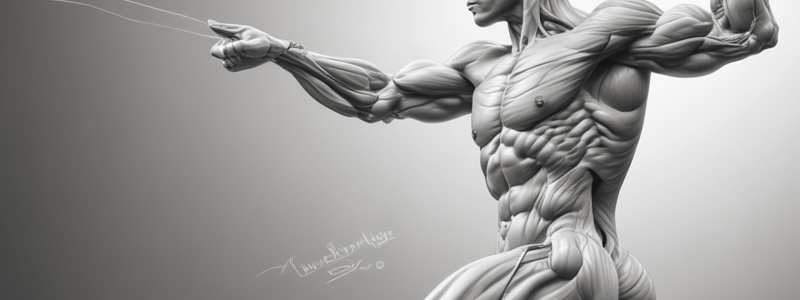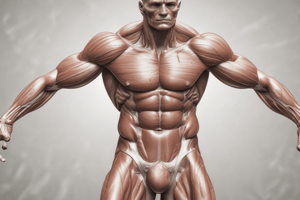Podcast
Questions and Answers
What is the primary function of slow-twitch fibres in the human body?
What is the primary function of slow-twitch fibres in the human body?
- To generate high force production for short-duration activities
- To facilitate rapid, powerful movements
- To provide stabilization and support during low-intensity, long-duration activities (correct)
- To increase muscle endurance during high-intensity exercises
What is the typical distribution of slow-twitch fibres in human skeletal muscles?
What is the typical distribution of slow-twitch fibres in human skeletal muscles?
- 20-40%
- 10-30%
- 40-60% (correct)
- 60-80%
What is a characteristic of fast-twitch fibres that distinguishes them from slow-twitch fibres?
What is a characteristic of fast-twitch fibres that distinguishes them from slow-twitch fibres?
- High endurance and resistance to fatigue
- High myoglobin content
- High force production (correct)
- High mitochondrial density
What type of muscle fibre is more prone to fatigue?
What type of muscle fibre is more prone to fatigue?
What is a factor that contributes to muscle fatigue?
What is a factor that contributes to muscle fatigue?
What is the definition of muscle fatigue?
What is the definition of muscle fatigue?
What is the primary advantage of high myoglobin content in slow-twitch fibres?
What is the primary advantage of high myoglobin content in slow-twitch fibres?
How do the muscle fibre distributions of endurance athletes and sprint athletes differ?
How do the muscle fibre distributions of endurance athletes and sprint athletes differ?
What is the role of calcium ion release and uptake in muscle fatigue?
What is the role of calcium ion release and uptake in muscle fatigue?
What is the primary difference between slow-twitch and fast-twitch fibres in terms of their anaerobic and aerobic capacities?
What is the primary difference between slow-twitch and fast-twitch fibres in terms of their anaerobic and aerobic capacities?
What is the effect of sedentary lifestyle on muscle fibre distribution?
What is the effect of sedentary lifestyle on muscle fibre distribution?
How does the accumulation of lactic acid and other metabolic byproducts contribute to muscle fatigue?
How does the accumulation of lactic acid and other metabolic byproducts contribute to muscle fatigue?
Study Notes
Muscle Fibre Types
Slow-twitch Fibres
- Also known as Type I fibres
- Characteristics:
- High endurance and resistance to fatigue
- Low force production
- High myoglobin content, allowing for high oxygen storage
- High mitochondrial density, allowing for efficient aerobic energy production
- Functions:
- Designed for low-intensity, long-duration activities (e.g., distance running)
- Play a crucial role in posture, balance, and stabilisation
Muscle Fibre Distribution
- Human skeletal muscles consist of a mixture of fibre types
- Typical distribution:
- Type I (slow-twitch): 40-60%
- Type IIA (fast-twitch): 20-40%
- Type IIB (fast-twitch): 10-30%
- Distribution can vary depending on factors such as:
- Muscle group (e.g., leg muscles tend to have more Type I fibres)
- Training status (e.g., endurance-trained athletes tend to have more Type I fibres)
- Genetics
Fast-twitch Fibres
- Also known as Type II fibres (subdivided into Type IIA and Type IIB)
- Characteristics:
- High force production
- Low endurance and high fatigue rate
- Low myoglobin content, limiting oxygen storage
- Low mitochondrial density, relying on anaerobic energy production
- Functions:
- Designed for high-intensity, short-duration activities (e.g., sprinting)
- Important for rapid, powerful movements
Muscle Fatigue
- Defined as a decline in muscle force production over time
- Types of fatigue:
- Peripheral fatigue: due to changes in the muscle itself (e.g., ion imbalance, metabolic byproducts)
- Central fatigue: due to changes in the nervous system (e.g., reduced motor neuron activation)
- Factors contributing to muscle fatigue:
- Muscle fibre type (fast-twitch fibres are more prone to fatigue)
- Intensity and duration of exercise
- Environmental factors (e.g., temperature, humidity)
- Nutritional and hydration status
Studying That Suits You
Use AI to generate personalized quizzes and flashcards to suit your learning preferences.
Description
Understand the characteristics, functions and distribution of slow-twitch and fast-twitch muscle fibres, and learn about muscle fatigue and its contributing factors. This quiz covers the basics of muscle physiology and exercise science.




